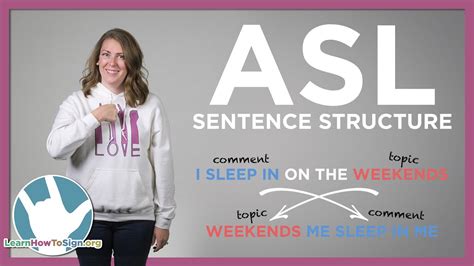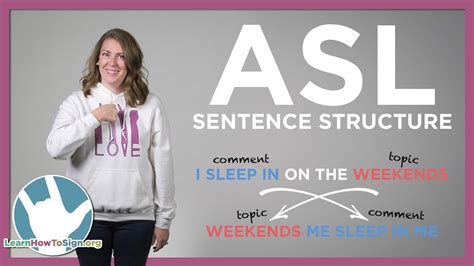The Ultimate Guide to ASL Sentence Structure

The world of American Sign Language (ASL) is a rich and vibrant one, offering a unique perspective on language and communication. Unlike spoken languages, ASL has its own set of rules and structures, creating a beautiful visual narrative. One of the most fascinating aspects is its sentence structure, which follows a logical pattern that is both distinct and expressive. In this comprehensive guide, we will explore the intricacies of ASL sentence structure, providing an in-depth understanding of how this visual language crafts meaning.
The Fundamentals of ASL Sentence Structure

At its core, ASL sentence structure is guided by the principles of topic-comment and subject-verb-object (SVO) word order. This means that the topic or subject is established first, followed by the comment or verb, and then any objects or additional information. However, it’s important to note that ASL, being a visual language, allows for flexibility and creativity in sentence construction.
Topic-Comment Structure
The topic-comment structure is a fundamental concept in ASL, akin to the subject-predicate structure in spoken languages. In this structure, the topic or subject is signed first, providing the context for the sentence. This is followed by the comment or verb, which adds the necessary action or description. For example, if you wanted to sign “The bird is flying,” you would first sign “BIRD,” establishing the topic, and then sign “FLY,” which is the comment or verb.
Subject-Verb-Object (SVO) Word Order
While the topic-comment structure provides the overall framework, the SVO word order is often employed within the comment section of a sentence. This means that after establishing the topic, the sentence follows an SVO pattern. For instance, if you wanted to sign “The cat chased the mouse,” you would first sign “CAT,” then “CHASE,” and finally “MOUSE.”
Flexibility and Creativity in ASL Sentence Structure

One of the most exciting aspects of ASL sentence structure is its flexibility. Unlike some spoken languages with rigid word order rules, ASL allows signers to play with the order of signs to emphasize different parts of the sentence or convey specific meanings. This flexibility adds depth and expressiveness to the language.
Emphasis and Emotive Sign Placement
Signers can manipulate the order of signs to emphasize certain elements of a sentence. For example, if you wanted to emphasize the object in the sentence “The boy threw the ball,” you could sign it as “BOY THROW BALL,” drawing attention to the object. This flexibility also allows signers to incorporate emotive signs or facial expressions to convey the tone or emotion of the sentence.
Incorporating Non-Manual Markers
Non-manual markers, such as facial expressions, head movements, and body posture, play a crucial role in ASL sentence structure. These markers can indicate the beginning and end of sentences, emphasize certain signs, or provide additional grammatical information. For instance, a raised eyebrow can signal a question, while a furrowed brow can indicate a negative statement.
The Role of Time and Location in ASL Sentences
Time and location are integral components of ASL sentence structure, often conveyed through specific signs or non-manual markers.
Indicating Time
ASL has a variety of signs to indicate different time frames, such as past, present, and future. These signs are often incorporated into sentences to provide context and timeline information. For example, the sign for “yesterday” can be used to indicate that an event happened in the past, while the sign for “tomorrow” can signal a future action.
Signifying Location
Location signs are also crucial in ASL sentences, especially when describing actions or events. These signs can indicate the direction or path of an action, as well as the starting or ending point. For instance, the sign for “over there” can be used to describe an action happening in a distant location.
Advanced Sentence Structures in ASL
As ASL signers gain more proficiency, they often explore more complex sentence structures, incorporating advanced techniques to convey nuanced meanings.
Incorporating Adjectives and Adverbs
In ASL, adjectives and adverbs can be signed before or after the noun or verb they modify, depending on the desired emphasis. For example, to describe a “beautiful sunset,” you could sign “BEAUTIFUL SUNSET” or “SUNSET BEAUTIFUL,” depending on whether you want to emphasize the beauty or the sunset itself.
Using Conjunctions and Connectives
Conjunctions and connectives are used to link ideas and sentences, providing a seamless flow of information. For instance, the sign for “and” can be used to combine two sentences or clauses, while the sign for “but” can introduce a contrasting idea.
Incorporating Idiomatic Expressions
ASL has its own set of idiomatic expressions, which often involve unique sign combinations or non-manual markers. These expressions add flavor and cultural specificity to the language, and understanding them is crucial for effective communication. For example, the sign for “rain check” in ASL doesn’t literally mean checking the weather; instead, it indicates a request to postpone or reschedule an activity.
Learning and Mastering ASL Sentence Structure

Mastering ASL sentence structure is a journey that requires practice, observation, and immersion in the Deaf community. Here are some tips to enhance your understanding and proficiency:
- Immerse Yourself: Engage with the Deaf community, attend events, and participate in activities where ASL is the primary language.
- Observe and Analyze: Pay close attention to the sentence structures used by native signers. Analyze how they convey meaning and express ideas.
- Practice with a Partner: Find a signing partner or join a signing group to practice your skills. Feedback and correction from others can greatly enhance your understanding.
- Study Grammar: Familiarize yourself with the grammatical rules and structures of ASL. This knowledge will provide a solid foundation for your signing.
- Explore Resources: Utilize online resources, books, and videos specifically designed to teach ASL sentence structure. These materials can offer structured learning paths and provide valuable insights.
Conclusion: The Art of ASL Sentence Structure
ASL sentence structure is a beautiful and intricate tapestry, offering a unique window into the world of visual language. By understanding the fundamentals, exploring the flexibility, and delving into the advanced techniques, you can unlock the full potential of ASL communication. Remember, language is a living, evolving entity, and ASL is no exception. Embrace the creativity and expressiveness that ASL sentence structure affords, and you’ll find yourself immersed in a rich and rewarding linguistic journey.
So, are you ready to embark on this fascinating linguistic adventure? The world of ASL sentence structure awaits your exploration!


